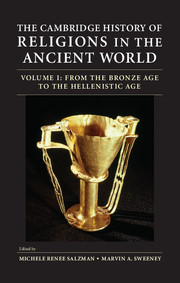Book contents
- Frontmatter
- Contents
- List of Figures and Maps
- List of Contributors
- List of Abbreviations
- Acknowledgments
- Introduction to Volumes I and II
- Introduction to Volume I
- Part I Mesopotamia and the Near East
- Part II Egypt and North Africa
- Part III Greece and the Eastern Mediterranean
- Part IV The Western Mediterranean and Europe
- Suggestions for Further Reading
- General Index
- Index of Citations
- Frontmatter
- Contents
- List of Figures and Maps
- List of Contributors
- List of Abbreviations
- Introduction to Volume II
- Part I Iran and the Near East
- Part II Egypt and North Africa
- 6 Traditional Religion in Ptolemaic and Roman Egypt
- 7 Judaism in Egypt
- 8 Ancient Egyptian Christianity
- 9 Cult and Belief in Punic and Roman Africa
- 10 Christianity in Roman Africa
- Part III Greece and Asia Minor
- Part IV Italy, Roman Gaul, and Spain
- Suggestions for Further Reading
- General Index
- Index of Citations
- References
6 - Traditional Religion in Ptolemaic and Roman Egypt
from Part II - Egypt and North Africa
Published online by Cambridge University Press: 05 October 2013
- Frontmatter
- Contents
- List of Figures and Maps
- List of Contributors
- List of Abbreviations
- Acknowledgments
- Introduction to Volumes I and II
- Introduction to Volume I
- Part I Mesopotamia and the Near East
- Part II Egypt and North Africa
- Part III Greece and the Eastern Mediterranean
- Part IV The Western Mediterranean and Europe
- Suggestions for Further Reading
- General Index
- Index of Citations
- Frontmatter
- Contents
- List of Figures and Maps
- List of Contributors
- List of Abbreviations
- Introduction to Volume II
- Part I Iran and the Near East
- Part II Egypt and North Africa
- 6 Traditional Religion in Ptolemaic and Roman Egypt
- 7 Judaism in Egypt
- 8 Ancient Egyptian Christianity
- 9 Cult and Belief in Punic and Roman Africa
- 10 Christianity in Roman Africa
- Part III Greece and Asia Minor
- Part IV Italy, Roman Gaul, and Spain
- Suggestions for Further Reading
- General Index
- Index of Citations
- References
Summary
Introduction
Over the course of three centuries, two successive conquests profoundly altered Egyptian society. The introduction of a new ethnic group into the country resulting from the Macedonian conquest in 332 seems not to have brought about major changes. Greco-Macedonians and Egyptians coexisted without great conflict. And Egypt in the hands of the Ptolemies remained, at least up until the second century BCE, an independent and prosperous kingdom. But in integrating Egypt into a vast empire of which it was only one province among many, the Roman conquest of 30 BCE far more profoundly transformed its institutions, administrative and economic organization, and Egyptian society as a whole. (See Map 4.) Henceforth, the practice of the traditional religion of Egypt occurred within the framework of a nation subject to “foreign occupiers,” but under very different circumstances.
The religious policy of the rulers
The new regimes did not demonstrate any hostility to the native Egyptian religion. What interested the conquering powers was the domination and exploitation of the territory, not the diffusion of their own religious cults in the vanquished nation. Because they resided in Egypt, the Lagids found it necessary to heed the reactions of a people obviously committed to its traditional forms of worship. This was far less the case for the emperors; barring rare exceptions, they did not set foot in a country that for them was basically, in the words of Tiberius, “sheep for shearing” (see Cassius Dio 57.10).
- Type
- Chapter
- Information
- The Cambridge History of Religions in the Ancient World , pp. 165 - 188Publisher: Cambridge University PressPrint publication year: 2013



